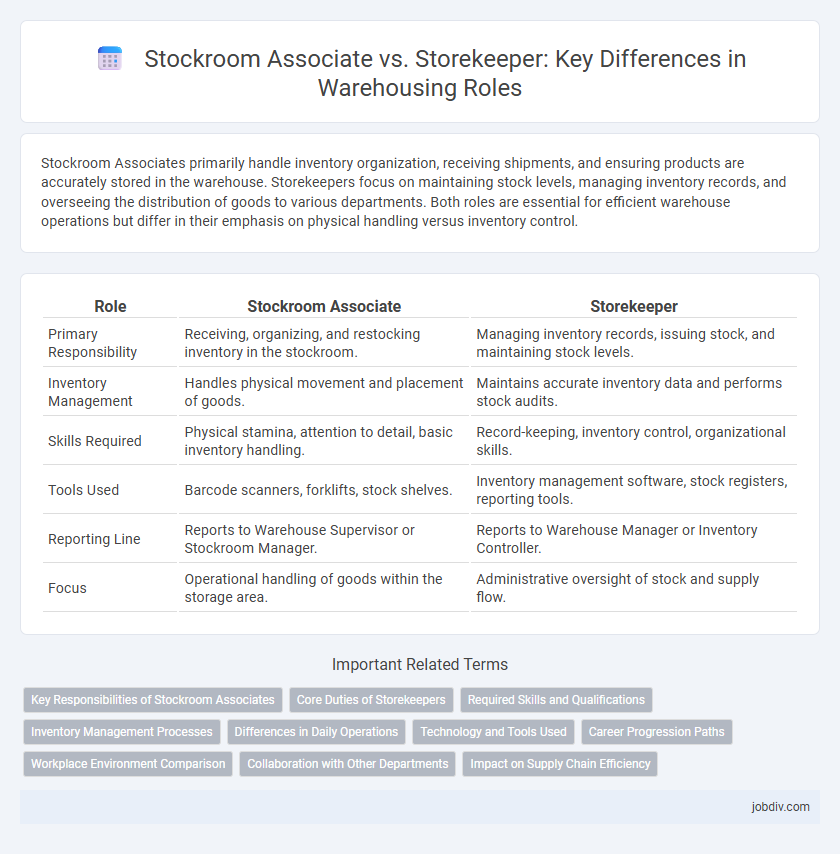Stockroom Associates primarily handle inventory organization, receiving shipments, and ensuring products are accurately stored in the warehouse. Storekeepers focus on maintaining stock levels, managing inventory records, and overseeing the distribution of goods to various departments. Both roles are essential for efficient warehouse operations but differ in their emphasis on physical handling versus inventory control.
Table of Comparison
| Role | Stockroom Associate | Storekeeper |
|---|---|---|
| Primary Responsibility | Receiving, organizing, and restocking inventory in the stockroom. | Managing inventory records, issuing stock, and maintaining stock levels. |
| Inventory Management | Handles physical movement and placement of goods. | Maintains accurate inventory data and performs stock audits. |
| Skills Required | Physical stamina, attention to detail, basic inventory handling. | Record-keeping, inventory control, organizational skills. |
| Tools Used | Barcode scanners, forklifts, stock shelves. | Inventory management software, stock registers, reporting tools. |
| Reporting Line | Reports to Warehouse Supervisor or Stockroom Manager. | Reports to Warehouse Manager or Inventory Controller. |
| Focus | Operational handling of goods within the storage area. | Administrative oversight of stock and supply flow. |
Key Responsibilities of Stockroom Associates
Stockroom Associates manage inventory accuracy by receiving, inspecting, and organizing incoming shipments to ensure proper storage and easy retrieval. They track stock levels, update inventory records with precision, and coordinate with warehouse teams to fulfill orders efficiently. Their role emphasizes maintaining a clean, safe, and well-organized stockroom environment to optimize operational flow and support overall warehouse productivity.
Core Duties of Storekeepers
Storekeepers manage inventory control by receiving, storing, and issuing stock accurately, ensuring proper documentation and record-keeping for efficient warehouse operations. They conduct regular stock audits and maintain organized storage areas to prevent discrepancies and streamline retrieval processes. Storekeepers also coordinate with suppliers and other departments to maintain optimal inventory levels and support timely replenishment.
Required Skills and Qualifications
Stockroom Associates require strong organizational skills, attention to detail, and proficiency in inventory management software to efficiently receive, store, and track merchandise. Storekeepers typically need advanced knowledge of supply chain logistics, record-keeping accuracy, and leadership abilities to oversee stock control and coordinate stockroom operations. Both roles demand physical stamina, basic math skills, and the ability to operate warehouse equipment safely.
Inventory Management Processes
Stockroom Associates ensure accurate inventory tracking by receiving, unpacking, and organizing stock while conducting regular cycle counts to maintain data integrity in warehouse management systems. Storekeepers oversee inventory control by managing stock issuance, monitoring reorder levels, and coordinating with procurement teams to prevent stockouts or overstock situations. Both roles contribute to efficient inventory turnover and minimize discrepancies, optimizing supply chain workflow.
Differences in Daily Operations
Stockroom Associates primarily handle receiving, organizing, and replenishing inventory within the warehouse, focusing on efficient stock rotation and order picking to maintain workflow. Storekeepers oversee inventory control, documentation, and storage condition monitoring, ensuring accuracy in stock records and compliance with safety standards. The key difference lies in Stockroom Associates' hands-on movement of goods versus Storekeepers' administrative and supervisory roles in inventory management.
Technology and Tools Used
Stockroom Associates primarily use handheld barcode scanners and inventory management software to efficiently track and organize stock within warehouse environments. Storekeepers often utilize advanced warehouse management systems (WMS) integrated with RFID technology to oversee stock control, asset management, and automated replenishment processes. Both roles leverage digital tools, but Storekeepers generally handle more sophisticated systems aimed at optimizing inventory accuracy and operational workflows.
Career Progression Paths
Stockroom Associates typically begin their careers handling inventory receipt, organization, and basic stock control tasks, gaining essential warehouse operational skills. Storekeepers advance by managing inventory accuracy, supervising stockroom activities, and coordinating with supply chain teams, positioning themselves for leadership roles such as inventory manager or logistics coordinator. Career progression from Stockroom Associate to Storekeeper often involves acquiring certifications in inventory management and developing expertise in warehouse management systems.
Workplace Environment Comparison
Stockroom Associates typically operate in busy retail environments where they manage inventory, restocking shelves and assisting customers, often requiring mobility and frequent interaction. Storekeepers usually work in industrial or warehouse settings, focusing on systematic storage, inventory control, and maintaining organized stockrooms with limited customer engagement. The workplace environment for Stockroom Associates is dynamic and customer-facing, while Storekeepers experience a more stationary, structured atmosphere centered on inventory accuracy and order.
Collaboration with Other Departments
Stockroom Associates closely coordinate with receiving and quality control teams to ensure accurate inventory tracking and timely product inspections. Storekeepers maintain communication primarily with procurement and logistics departments to manage stock replenishment and dispatch schedules effectively. Both roles rely on seamless interdepartmental collaboration to optimize warehouse operations and maintain supply chain efficiency.
Impact on Supply Chain Efficiency
Stockroom Associates enhance supply chain efficiency by managing accurate inventory counts and ensuring timely restocking, which minimizes delays in order fulfillment. Storekeepers focus on organizing and securing stock, maintaining optimal storage conditions, and coordinating with procurement to prevent stockouts and excess inventory. Both roles are pivotal in reducing operational bottlenecks, improving inventory accuracy, and supporting seamless supply chain flow.
Stockroom Associate vs Storekeeper Infographic

 jobdiv.com
jobdiv.com